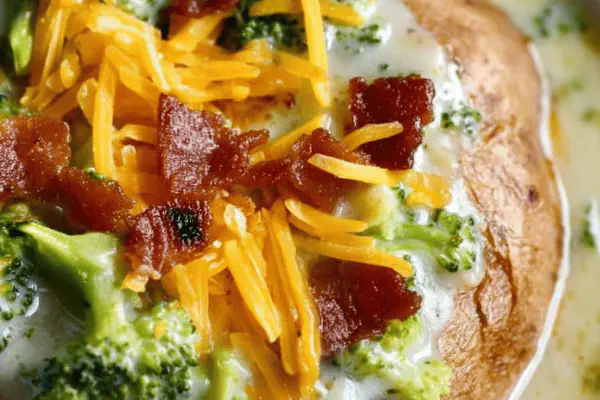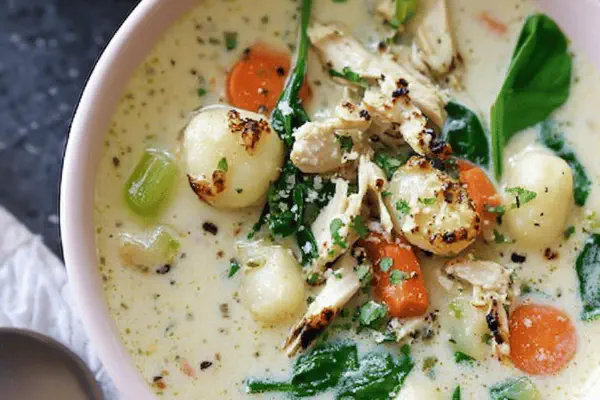Smoky Kraut Soup

E
By Emma
Certified Culinary Professional
•
Recipe tested & approved
A smoky, tangy soup combining potatoes, kielbasa, sauerkraut with herb hints. Butter starts the base; onions and celery add crunch and aroma. Potatoes soften slowly, absorbing broth and juices from kielbasa. Apple cider vinegar swaps in place of apple juice for a sharper kick. Salt and pepper adjust balance; sour cream can mellow the acidity or serve as a garnish. A slow simmer melds flavors. This dish plays on contrasts: soft potatoes, tangy kraut, smoky sausage and herbal undertones. Rustic, satisfying midweek meal with hunter’s notes.
Prep:
12 min
Cook:
22 min
Total:
34 min
Servings:
6 servings
#soup
#Eastern European
#kielbasa
#sauerkraut
#comfort food
#potatoes
Start with butter melting slow in a heavy pot. The sizzle is your first clue the meal is starting right. Toss in diced potatoes—not too big or they won’t cook evenly; too small and turn to mush. I watch for the edges turning translucent, the faint smell of softened starch. Onion and celery follow; aroma changes from starch to fresh veggie. You want them tender with a little snap, not mushy or limp. Then kielbasa, that smoky punch enters the room. Sauerkraut, that zingy tang, wakes the dish up. Dried marjoram adds herbal lift, but not too much or it becomes a garden party in the pot.Simmer gently with broth. Stir often but not aggressively so potatoes stay intact. The liquid thickens slightly as starch leaches. Apple cider vinegar finishes the smoky-sour balance but beware overpowering. Salt carefully; sauerkraut, kielbasa already salty. And sour cream? Creamy antidote to acidity—sometimes a swoosh on top, sometimes folded in. Rustic, messy, honest flavors. Winter comfort food with bite and soul.
Ingredients
- 3 tablespoons unsalted butter
- 2 large russet potatoes, peeled and diced small
- 1 medium yellow onion, chopped
- 2 celery stalks, chopped
- 12 ounces smoked kielbasa, sliced into 1/4 inch rounds
- 1 1/2 cups sauerkraut, drained and squeezed to remove excess liquid
- 1 teaspoon dried marjoram
- 4 1/2 cups low sodium chicken broth
- 1/4 cup apple cider vinegar
- Kosher salt, to taste
- Freshly cracked black pepper, to taste
- 1/2 cup sour cream, optional for serving
About the ingredients
Butter is essential—not just fat but flavor carrier. Use salted if you must but adjust salt later. Russet or Yukon gold potatoes preferred. Baking potatoes stay firmer; waxy types will get gummy. Onion and celery must be fresh and crisp; avoid limp produce. Kielbasa choice matters—smoked, spicy, or even a garlic variant brings variations. Substitute with smoked sausage if out of kielbasa but reduce salt addition. Sauerkraut drained well before adding. Excess liquid turns broth sour and watery. Dried thyme replaced with marjoram here for personal preference—either works but marjoram softer. Broth low sodium so you control salt. Apple cider vinegar sharper than original apple juice; balance with a pinch of sugar if too tart. Sour cream optional but very welcome contrast. Parsley garnish can add freshness if desired.
Method
- Butter warms in heavy pot over medium heat; listen for gentle sizzle but no browning. Toss diced potatoes in. Stir occasionally. Potatoes start going translucent around edges but still firm. Patience here rewards texture; mushy potatoes ruin the mouthfeel.
- Add chopped onion and celery after about 5 minutes. The onion starts smelling sweet; celery still crunchy but softening. Cook until veggies nearly tender and onions just losing bite, about 4 minutes. Avoid limp or brown vegetables here.
- Drop sliced smoked kielbasa in; the kitchen will smell smoky sharp. Toss in sauerkraut next with dried marjoram. Quick stir, 90 seconds max. Want flavors hitting but sauerkraut shouldn’t shrink into sad stringiness.
- Pour in chicken broth next; flame down a notch to low simmer. Visual clue: small bubbles breaking gently – not a rolling boil – let potatoes fully soften. Typically 7-12 minutes here, but press a cube to test. Soft, creamy inside. Don’t rush or the broth will turn cloudy and murky.
- Stir in apple cider vinegar for brightness—vinegar has punchy tang that apple juice couldn’t match; if you want milder then substitute honey and water mix instead. Season with salt and pepper slowly, tasting as you go. Sauerkraut brings its own saltiness. Better to add less, re-season later.
- Optional swirl in sour cream. Adds richness and calms the acidity. I prefer serving it on top so people can decide. Plus adds nice creamy texture contrast against soft stew-like soup.
- Serve hot; crusty rye bread ideal. This isn’t for dainty dinners—the bowl steams, aromas punch the nose, sausage fatty snap, kraut vinegary crunch, soft potatoes blankety but not pasty. Makes for deep, rustic eating. Leftovers? Soup thickens overnight; add broth or water when reheating to loosen. Everything blends better next day.
Cooking tips
Start gently—medium heat butter melting first step. Avoid splattering by waiting until fully melted before potatoes go in. Potatoes take time; look for edges translucent and softening—not collapse. Onion and celery added while potatoes partially cooked helps layers. Listen for faint sizzling but no browning. Onions translucent, celery crisp-tender. Don’t rush or you lose texture contrast. Kielbasa must heat through quickly; too long shrivels it. Sauerkraut goes last of solids to avoid turning stringy and bitter. Low simmer after broth addition avoids cloudy soup and broken potatoes. Use visual rather than time: bubbles barely breaking surface. Test potato softness by poking—smooth resistance, not hard or falling apart. Vinegar or juice last; add gradually and season slowly. Taste often to avoid overpowering acidity. Sour cream folds in creamy shimmer but add off heat to prevent splitting. Reheat carefully; soup thickens so add broth or water as needed.
Chef's notes
- 💡 Butter must melt fully, no noise beyond gentle sizzle. Toss potatoes after, keep sizes uniform. Watch edges turn translucent not mush. Stir sparingly, avoid breaking up cubes. Texture matters - soft but intact wins.
- 💡 Onion and celery timing key. Add after potatoes soften but before fully tender. Onions should turn translucent, celery still a bit crisp. Avoid brown spots or limp edges - means heat too high or too long.
- 💡 Kielbasa heats fast. Sliced rounds jump in after veggies, quick stir with sauerkraut and dried marjoram next. Too long and sausage dries. Sauerkraut stays plump, not stringy or bitter. Marjoram chosen over thyme for softer herbal note.
- 💡 Simmer low once broth hits. Watch for tiny bubbles, no roar or rolling boil. Time varies but 7-12 mins usually. Test potato by pressing - creamy inside, holds shape. Cloudy broth means boiled too hard or broken potatoes.
- 💡 Add vinegar last, slowly. Punchy tang sharpens but can overpower if rushed. Substitute mild mix of honey and water for less acidity. Salt and pepper added carefully; sauerkraut and kielbasa bring inherent saltiness. Adjust toward end.
- 💡 Sour cream optional, add off heat to avoid curdling. Swirled on top preserves creaminess and contrast with tangy broth. Can fold gently if desired but texture shifts. Helps mellow sharp edges without muting smoky punch.
- 💡 Leftovers thicken overnight, normal starch gelatinizes. Reheat with splash of broth or water. Consistency loosens, flavor melds deeper day after. Rye bread on the side anchors the bowl, gives crunch to soft tender stew.
Common questions
Can I replace kielbasa?
Use smoked sausage but watch salt levels down. Different spices come through; less smoky sometimes. Adjust seasoning carefully.
Why does broth get cloudy?
Potatoes breaking down or simmering too hard. Gentle heat needed. Stir lightly. Skim if scum forms. Timing helps.
Best potato type?
Russet or Yukon gold. Baking potatoes hold shape. Waxy get gummy fast. Dice small, uniform sizes. Test doneness visually, edges hint softening.
How to store leftovers?
Cool before fridge. Soup thickens, add broth or water on reheat. Freezing works fine but texture softens more. Stir well after thaw.



